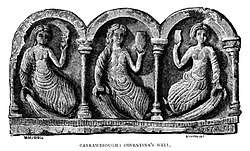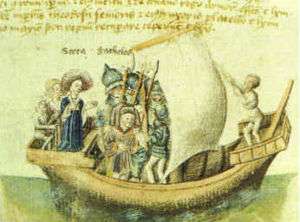Goídel Glas
According to an Irish and Scottish medieval tradition, Goídel Glas (Latinised as Gaithelus) is the creator of the Goidelic languages and the eponymous ancestor of the Gaels.
| Part of a series on |
| Celtic mythology |
|---|
 |
| Gaelic mythology |
| Brythonic mythology |
| Concepts |
| Religious vocations |
| Festivals |
|
The tradition can be traced to the 11th-century Lebor Gabála Érenn (LGE). A Scottish variant is due to John of Fordun (d. 1384).
Lebor Gabála Érenn
The narrative in the Lebor Gabála Érenn is a mythological account of the origin of the Gaels as the descendants of the Scythian prince Fénius Farsaid, one of seventy-two chieftains who built the Tower of Babel. Goídel Glas was the son of Nel (son of Fénius) and Scota (daughter of a Pharaoh of Egypt).[1] Goídel Glas is credited with the creation of Gaelic (proto-Irish language) from the original seventy-two languages that arose at the time of the confusion of tongues.[2] His descendants, the Gaels, undergo a series of trials and tribulations that are clearly modelled on those of the Israelites in the Old Testament. They flourish in Egypt at the time of Moses and leave during the Exodus; they wander the world for 440 years before eventually settling in the Iberian Peninsula. There, Goídel's descendant Breogán founds a city called Brigantia, and builds a tower from the top of which his son Íth glimpses Ireland. Brigantia possibly refers to Bragança, in Portugal, or perhaps Corunna, in Galicia, (then known as Brigantium),[3] whilst Breogán's tower might have been based on the Tower of Hercules, which was built at Corunna by the Romans.[4]
An anecdote in the LGE tells how Gaidel Glas, son of Nel (Keating: Niul), was cured of a serpent's sting when Moses made fervent prayer and touched his rod upon the lad's wound.[5] An inserted verse in an earlier passage says of Gaidel: "green were his arms and his vesture".[6] O'Clery's redaction of the Lebor Gabála adds that the snake bite left a green ring on the boy, from which he earned his nickname of Gaidel Glas (meaning "Green").[7] Keating also repeats this quoting a glossarial verse, although he prefaces it with an alternate derivation of the nickname from the word for lock (Irish: glas)[8][9]
John of Fordun

A Scottish version of the tale of Goídel Glas and Scota was recorded by John of Fordun. This is apparently not based on the main Irish Lebor Gabála account. Fordun refers to multiple sources, and his version is taken to be an attempt to synthesise these multiple accounts into a single history.
In Fordun's version, Gaythelos, as he calls Goídel Glas, is the son of "a certain king of the countries of Greece, Neolus, or Heolaus, by name", who was exiled to Egypt and took service with the Pharaoh, marrying Pharaoh's daughter Scota. Various accounts of how Gaythelos came to be expelled from Egypt—by a revolt following the death of Pharaoh and his army in the Red Sea, pursuing Moses, or in terror from the Plagues of Egypt, or after an invasion by Ethiopians—are given, but the upshot is that Gaythelos and Scota are exiled together with Greek and Egyptian nobles, and they settle in Hispania after wandering for many years. In the Iberian Peninsula they settle in the land's northwest corner, at a place called Brigancia (the city of A Coruña, that the Romans knew as Brigantium).
Gaythelos was considered the founder of the Portuguese city of Porto by some old authors. According to them, he landed in the Iberian Peninsula in a harbor that he named "Portus Gaythelos" (later named by the Romans Portus Cale after the Callaici people), the town later giving its name to Portugal.[10]
See also
- Fénius Farsaid
- Gaels
- Tower of Babel
- Mythological Cycle
- Irish mythology
- Celtic mythology
- Shem (Eponymous ancestor of Semites)
- Ham (Eponymonous ancestor of Hamites)
- Japheth (Eponymous ancestor of Japhetites)
- Lech, Czech, and Rus (Eponymous ancestors of Lechites, Czechs, and Rus' people)
- Angul (Eponymous ancestor of Angles)
- Asena (Eponymous ancestors of Turkic peoples)
- Romulus and Remus (Eponymous ancestors of Rome)
- Dan (Eponymous ancestor of Denmark)
- Nór (Eponymous ancestor of Norway)
- Ríg (Eponymous ancestor to Iceland)
- Table of Nations
Footnotes
- Macalister 1939 ¶140
- Macalister 1939, Vol. 2, p. 13 (¶107) "It is Gaedel Glas who fashioned the Gaelic language out of the seventy-two..."; Macalister (p. 5) adds "Kg [Keating] ascribes it to a different Gaedel, s. [son of] Ethor, unknown to LG"
- Encyclopædia Britannica, "A Coruña".
- Harry Mountain, The Celtic Encyclopaedia, p. 380
- Macalister 1939, Volume II, pp. 59–61 (¶143–145)
- Macalister 1939, p. 93, Poem No. XIII
- O'Cléirigh & Macalister 1916, LG, Vol. 1, p. 197 (§128) "Aaron went to Moses after that, and tells him the hearty welcome that Nel, son of Fenius, gave them, ... [Nel had a son, and] a venomous serpent wound itself around him so that death was near him... Moses made vehement and diligent prayer to God, when the boy reached him, and he struck the famous rod on the serpent till he cleft it in two. The boy was sound at once. There was a green ring on him in the place where the serpent had coiled about him, from that out to his death, so that thus Glas ["Green"] stuck to him as an extra name."
- Comyn & Dinneen 1902, vol. 2, p.19 (Keating, §16): "Some seanchas state that Moses fastened [his bracelet] with a lock..." etc.; the passage also seems to suggest the nickname also has to do with the word fleascach, glossed here as 'bracelet-bearer' denoting an authority figure, even though 'fleasc' normally means a staff or rod.
- Macalister's 5-volume edition of LGE, 1938–, see: Vol. 1, p. xxvii; Vol. 2, pp. 4–5 (commentary), p. 35 (¶119), pp. 59, 61 (¶143–145), p. 123 (verse XVIII to ¶144), p. 134 (notes to ¶119), p. 157; Vol. 3, p. 198
- Joseph Fr. Michaud, Louis Gabriel Michaud Biographie universelle, ancienne et moderne, ou, Histoire par ordre alphabétique de la vie publique et privée de tous les hommes qui se sont fait remarquer par leurs écrits, leurs actions, leurs talents, leurs vertus ou leurs crimes: ouvrage entièrement neuf, Volume 54 (in French) Michaud, 1832 p. 312
References
- Broun, Dauvit, The Irish Identity of the Kingdom of the Scots in the Twelfth and Thirteenth Centuries. Boydell, Woodbridge, 1999. ISBN 0-85115-375-5
- Ferguson, William, The Identity of the Scottish Nation: An historic quest. Edinburgh U.p, Edinburgh, 1998. ISBN 0-7486-1071-5
- Geoffrey Keating, History of Ireland, §16
- Comyn, David; Dinneen, Patrick Stephen (1902), The history of Ireland (google), Irish Texts Society, 2, London: D. Nutt[series: ITS Vols. 4, 8, 9, 15] (ed. & tr.)
- John of Fordun, Chronicle of the Scottish Nation, ed. William Forbes Skene, tr. Felix J.H. Skene, 2 vols. Reprinted, Llanerch Press, Lampeter, 1993. ISBN 1-897853-05-X
- MacKillop, James, The Oxford Dictionary of Celtic Mythology. Oxford U.P., Oxford, 1998. ISBN 0-19-860967-1
- Macalister, Robert Alexander Stewart, 1870–1950 (1939), Lebor gabála Érenn: The book of the taking of Ireland (snippet), 2, Dublin: Irish Texts Society by the Educational Co. of Ireland
- O'Cléirigh, Micheál (1916), Leabhar Gabhála: The Book of Conquests of Ireland: The Recension of Micheál, Dublin: Irish Hodges, Figgis and Company